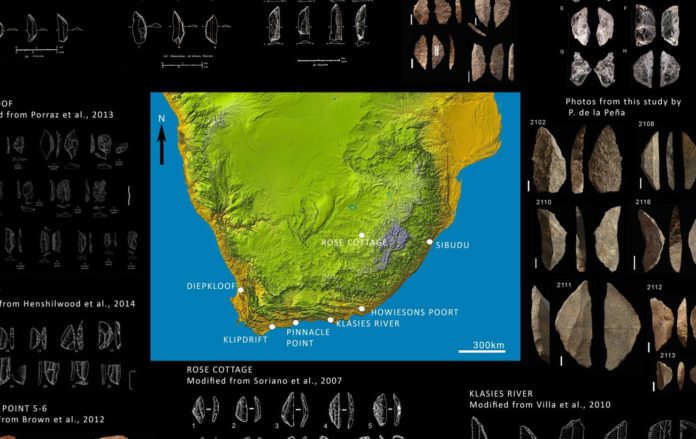In a first-of-its-kind discovery, an international team of scientists led by Dr. Amy Mosig Way, an archaeologist from the Australian Museum and the University of Sydney, discovered that prehistoric humans across southern Africa crafted the same kind of stone tool, the backed artifact. The study, which was published in Scientific Reports, makes it clear that the two groups must have met.
The researchers revealed that the Howiesons Poort backed artifacts, also known as the “stone Swiss Army knife” of prehistory, were fashioned according to a consistent blueprint across vast distances and diverse biomes. During this historical period, approximately 65-60 thousand years ago, these artifacts were manufactured across southern Africa in large quantities.
Dr. Way, the lead author, explained that these tools were made in a variety of shapes around the world, but because people in southern Africa chose to make them look the same, it indicates that they were sharing information and communicating with one another, indicating that they were socially connected.

“People have walked out of Africa for hundreds of thousands of years, and we have evidence for early Homo sapiens in Greece and the Levant from around 200 thousand years ago. But these earlier exits were overprinted by the big exit around 60-70 thousand years ago, which involved the ancestors of all modern people who live outside of Africa today,” Dr. Way explained.
“Why was this exodus so successful where the earlier excursions were not? The main theory is that social networks were stronger at this time. This analysis shows for the first time that these social connections were in place in southern Africa just before the big exodus,” Dr. Way continued.
Dr Paloma de la Pea, a senior research associate at Cambridge University’s McDonald Institute for Archaeological Research who studies the cultural behavior of early Homo sapiens, said the backed artefact has been associated with a variety of domestic activities such as cutting and scraping, as well as hunting activities (they were sometimes part of projectiles).
“While the making of the stone tool was not particularly difficult, the hafting of the stone to the handle through the use of glue and adhesives was hard, which highlights that they were sharing and communicating complex information with each other,” Dr. de la Pea noted.
“What was also striking was that the abundance of tools made in the same shape coincided with great changes in the climatic conditions.” Dr. de la Pea continued, “We believe that this is a social response to the changing environment across southern Africa.”
Professor Kristofer Helgen, Chief Scientist of the Australian Museum, remarked that ancient humans, like us, relied on collaboration and social networking, and that this research gives an early dated observation of this behavior.

“Examining why early human populations were successful is critical to understanding our evolutionary path. Professor Helgen remarked, “This research provides new insights into our understanding of those social networks and how they contributed to the expansion of modern humans across Eurasia.”
Another remarkable element about this tool – the backed artifact – according to Dr. Way is that it was created independently by many different groups of individuals all across the world, including here in Australia.
“I compared some of the Australian shapes from five thousand years ago with the African shapes 65 thousand years ago (as they can’t possibly be related), to show the southern African tools all cluster within a much larger range of possible shapes,” Dr. Way added.
Dr. de la Pea’s prior studies in southern Africa revealed that backed items were utilized as barbs in hunting technology. Dr Val Attenbrow, an Australian Museum Senior Fellow and archaeologist, has demonstrated that these artefacts were employed for a number of functions and purposes, including working bone and hide and drilling and shaping wooden objects, in addition to making armatures in spears.
Image Credit: the Australian Museum
You were reading: New Research Reveals The Secrets Of Early Humans’ Success
